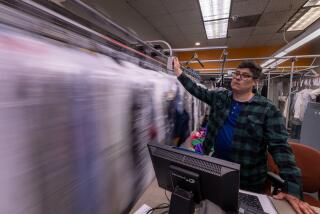Figuring Out How L.A. Got to Be a Mess
- Share via
To figure out why Los Angeles is such a sprawling mess, it’s important to understand how someone like Arthur K. Snyder earns his living.
I’m not saying that Snyder, a lawyer-lobbyist and former L.A. city councilman, is single-handedly responsible for the city’s undisciplined hodgepodge--high-rises, manufacturing plants, freeways, apartments, giant shopping malls, mini-malls and condos interspersed with vast neighborhoods of single-family homes.
But his efforts to convert the abandoned downtown May Co. department store into a huge combination garment factory-shopping mall is a perfect illustration of how L.A. got the way it is.
The stocky, red-faced, red-haired Snyder occupies a large, expensively furnished suite on the 37th floor of the IBM Tower in downtown’s Wells Fargo Center, just a few miles from the poor neighborhood where he grew up.
“The day we moved into this office,” he told me, “I came back at night. Everyone was gone. I sat here alone, looked out the window and thought: ‘Pretty good for a poor kid from Lincoln Heights.’ ‘
He put every bit of his Lincoln Heights toughness to work when Belfour Shalomi and Amantollah Simantob came to him for help. They needed the City Council to approve their plan to turn the old May Co. department store into a garment factory that would employ 7,000.
Believe it or not, there’s a plan for downtown, and the Shalomi-Simantob garment factory proposal just doesn’t fit in. The Central City Plan envisions the May Co. building, at 8th Street and Broadway, as part of a residential and small retail area known as South Park, reaching from the Santa Monica Freeway north to 8th Street.
Snyder launched an all-out attack. He got endorsements from almost every merchant on Broadway, including some big supporters of Mayor Tom Bradley. The mayor’s Community Redevelopment Agency climbed on board. Briefings and briefing books went out by messenger to council members, Bradley’s staff and the press.
When I interviewed Snyder in his office, we sipped excellent coffee and nibbled terrific chocolate chip cookies. He showed me large maps of the area, with blocks colored bright red, marking the many buildings around the May Co. site that already are devoted to the garment trade. So much for the Central City Plan, he said.
I listened to Snyder explain that the May Co. building would be no mere garment factory, no super sweatshop, but a high-rise industrial park, bringing prosperity to faded old Broadway.
But the plan has formidable foes. And the story I liked most was when Snyder described how he hired his own building inspector to nail one of his critics for safety violations.
His opponents had urged the council to drastically scale back the project. They owned and operated their own old garment industry buildings in the area and they regarded the May Co. plan as unfair competition.
Two of them--Jack Needleman and Stanley Hirsch--are big contributors to Bradley and other political candidates and have many friends in high places. The third, Richard Gerry, a lawyer managing his family’s buildings, has not been part of the political scene.
Snyder was smart enough not to send his private building inspector to the factories owned by the politically influential Needleman and Hirsch. Instead, he dispatched his man to a Gerry building on a surprise raid.
“How did he get in?” I asked Snyder. “He just walked in,” Snyder said. “They let him in. You know, he had a bunch of pens in his shirt pocket, he was wearing an old sport coat, he was carrying a clipboard. He looked like a building inspector.”
This “inspection” claimed there were many violations in Gerry’s building. Snyder forwarded it to City Atty. James Hahn, along with a letter warning that “the lives of the persons at risk are now in your hands.” A team of city building inspectors soon was swarming over Gerry’s building. They found violations, which Gerry said he is fixing.
As you can see, none of this had anything to do with planning.
The Snyder inspection had the effect of smearing the opponents--unfairly, they said. Unfair or not, it cast Snyder’s foes in a bad light and undoubtedly cost them council support. The council approved Snyder’s project.
Bradley, who wanted severe restrictions placed on the project so it would be more in line with the Central City plan, vetoed it. But the battle is not over.
Deputy Mayor Mark Fabiani said that compromise talks will begin on Monday. So, in the end, I’m sure there will be a compromise. The super garment factory will probably be authorized, with enough restrictions to satisfy the mayor.
And I’ll bet a chocolate chip cookie that Arthur K. Snyder’s clients won’t come out losers.
More to Read
Sign up for Essential California
The most important California stories and recommendations in your inbox every morning.
You may occasionally receive promotional content from the Los Angeles Times.










